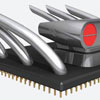
IP Video Tips
How CPU's and processor speeds affect system design
- By Jeff Stout
- Jun 01, 2012
All NVR and hybrid recorders are not created equally. Every manufacturer
has different CPU and throughput speed specifications.
These two factors are key in determining the types and numbers
of cameras that can be connected to the recording device.
If your customer requires higher megapixel or HD-resolution cameras,
the CPU and throughput speed will limit the number of cameras and/or the
frame rates. In turn, a customer requiring a greater number of cameras for an
installation will sacrifice resolution and frame rates due to the processor and
speed of the device. Check with the manufacturer or contact your local Tri-
Ed/Northern Video representative to make sure that your system is capable of
meeting the requirements of your installation.
Video Codecs - H.264 vs. M-JPEG
The H.264 codec for compressing and decompressing video comes in several
varieties. Blu-ray and broadcast HDTV use the High Profile standard (Level
4.1 of H.264) and can deliver full 1080p resolution. This standard of H.264
is CPU and storage intensive and is rarely used in the IP video surveillance
space for this reason.
The Baseline Profile of H.264 is less CPU and storage intensive, but cannot
deliver the high-quality video that the High Profile standard delivers. The
Baseline Profile is the most commonly used standard in IP video surveillance
systems. M-JPEG offers high-quality video but less processing power, and
it requires more storage space. With the cost of storage
decreasing steadily, M-JPEG is a viable standard for IP
video when quality is the most important feature required
by the customer.
It is critical to determine the proper codec required
of the system design so that the end user
ultimately receives the video quality and system
performance desired.
Running a Parallel Nework
for Better Perform ance
One way to maximize the success of an IP video
network is to run a parallel network dedicated to security.
There are many reasons to do this, but some of the most
important are:
- a greater level of security when using your own network as opposed
to a customer’s network and all of its vulnerabilities;
- easier network troubleshooting—should issues arise if you do not have to
worry about devices on your customer’s existing network;
- ]parallel network allows for the use of all of the available bandwidth on
your switches without interfering with existing network operation; and
- more IT departments accepting a parallel network because it will not decrease
the performance of an existing network and can be easily detached
in the event of network issues.
Parallel networks are a “best practice” when implementing an IP-based
video system.
How to Capture a License Plate
How many of us have been on a job where the customer is convinced that he
or she absolutely must see license plates? Well, here is a good guideline to follow
to ensure success on your job.
To capture license plates, users will need 5 pixels per inch or 60 pixels
per foot. If users have a driveway that measures 20 feet horizontally, they
need a camera that has 1,200 horizontal pixels to capture license plates. A
single 1.3-megapixel camera is more than capable of providing that type of
resolution.
This article originally appeared in the June 2012 issue of Security Today.
About the Author
Jeff Stout is the network solutions manager at Tri-Ed/Northern Video Distribution.